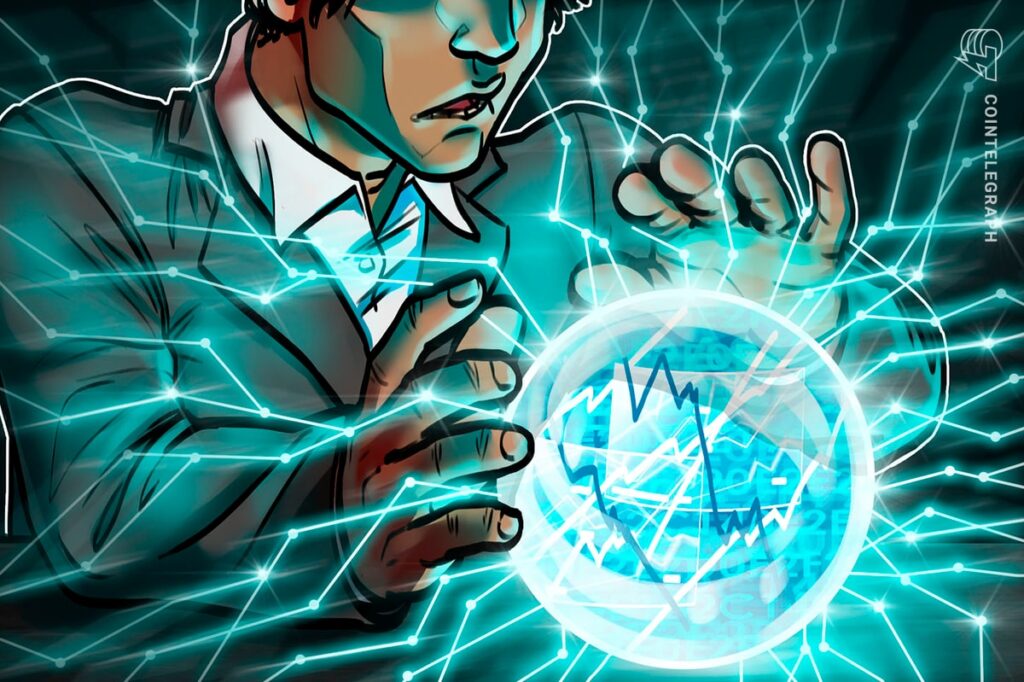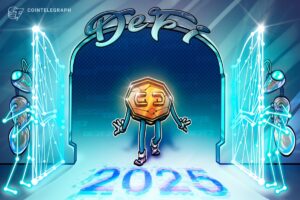Could Blockchain Solutions Disrupt US Inflation Forecasts?

So much of the world's economic steam is based on interest rates, which in turn are linked to inflation, i.e. rising producer and consumer prices.
But measuring inflation is not easy. It is an art like science.
The world's number one inflation index is the US Bureau of Labor Statistics' (BLS) Consumer Price Index (CPI), which has been around for over 100 years.
Not all economists and business leaders are happy with the CPI. His method sometimes seems primitive, and he publishes only once a month. It also relies on 477 people who canvas supermarkets, department stores, gas stations and hospitals, often underwriting retail prices – just not in the 21st century.
“Basically, they go to stores — either electronically or physically — and write down prices. They compare those prices to a month ago,” David Berson, chief economist for Nationwide Insurance, told Marketplace.
That's probably why blockchain-based inflation data Truflation.com is getting some attention right now. It collects digital data from 40 “partners,” or sources that collectively provide up to 18 million data points, compared to the CPI's relatively modest 80,000 data points. Truflation also has a UK version.
The new inflation index is also updated daily. If ever-increasing consumer prices start to fade or fall, they should be able to pick up changes ahead of the government measure.
Economist Paul Krugman wrote in a New York Times column in late October: “I've been enjoying a project called TrueFlation, which supposedly uses blockchain and is partially supported by crypto-types, and I suspect it's meant to demonstrate that.” Official inflation was very low. The number shows a higher rate of inflation compared to last year.
Never mind digging into “crypto types” – Krugman is a known crypto skeptic. Interestingly, this Nobel laureate was taking blockchain-based inflation analysis seriously.
Commenting on inflation last year, Rockefeller Capital Management chairman David Harris said: “Their inflation data last fall looked accurate, because it showed improvement before the BLS did.” I expect more websites like this to provide investors with more ways to assess inflation.
Elsewhere, the Base Ecosystem Fund, which invests in “building next-generation on-chain projects based on Base,” Coinbase's Layer-2 blockchain, announced in September that Truflation was among the first six investment recipients out of 800 applications.
Digital data sources include NielsenIQ, Big Mac Index, Amazon, Walmart, Zillow, Trulia, Penn State University MRI (Marginal Rent Inflation) Index, Real Capital Analytics, Yahoo, Energy Information Administration, OPIS, AAA Gas Prices, JD Powers, CarGurus. , Numbeo, Statista, CoreLogic and Kantar and others.
Cleveland Fed Nowcasts
He is not the first person to launch real-time inflation forecasting. The Federal Reserve Bank of Cleveland created a real-time inflation index called “Nowcasts” in 2014, and today the bank releases monthly inflation forecasts before the release of official CPI or personal consumption expenditures (PCE) inflation data. The index is updated every morning at 10:00 am.
The idea is to give consumers, businesses, financial markets, and others a sense of where inflation is now and “where it might be in the future.” example:
“If a consumer is considering taking out a loan, it helps to know how quickly wages and prices will increase over the life of the loan – after all, it will be much easier to service the loan with strong wage and price growth.”
The Nowcast model uses a small number of data series, the bank said, including “daily oil prices, weekly fuel prices, and monthly CPI and PCE inflation.”
It found some success, saying it was “more accurate than the current consensus (average) of the survey of blue-chip economic indicators” and also “more accurate than the Federal Reserve Bank's Survey of Professional Forecasters.”
The need for real-time measurements
Real-time inflation indexes like Nowcast and Truflation are long overdue in the eyes of many. “There is an important element of independent inflation that is calculated more frequently than once a month,” Omid Malekan, author and assistant professor at Columbia University's business school, told Cointelegraph.
Magazine: 6 questions for Luigi Tillier about Bitcoin, Ordinals and the future of crypto
“Today, we have millions of prices to look at in real time and there is no reason to delay publishing inflation data for the first time – so we can see them in real time if we want,” said Lars Christensen, an economist and associate professor at Copenhagen Business School, in a recent LinkedIn post.
The view that the BLS CPI is antiquated and ripe for inflation is “a major reason for inflation,” the organization's founder and CEO, Stephan Rust, told Cointelegraph. He said the new protocol will track 18 million items in three price feeds, compared to the 80,000 items the government collected “manually”:
“Instead of tracking household expenses through rotating panels, Truffle uses a census-based model to track these.”
Of course, there is no clear “right way” to track inflation, but that is arguably another reason to embrace new approaches. There is a lot of discretion in any formula when answering questions about how much weight to give to different goods or services.
“The Department of Labor claims to be an independent watchdog, but there is a huge conflict of interest in the formula because billions of dollars in TPS payments. [which protect against inflation] And cost-of-living adjustments for services like Social Security are how we calculate inflation.
Rust echoed this sentiment, saying the government's system is not only antiquated, but biased, telling Cointelegraph that the government's system is “vertically coordinated, biased, and adjustable.” While working with old data sets, you can change method and time sets at will.
97% correlation with CPI
Overall, the creation of apps like Truffletion is “a very healthy development,” Danielle DiMartino Booth, CEO and chief strategist at QI Research, told Cointelegraph.
Booth, who worked at the Dallas Federation for a number of years, was among those who “tested” the Truflation model. The organization provided raw data so that QI could conduct correlation analysis. Since 2012, the index's correlation with the CPI has been 97%, Booth said, which is very high.
As mentioned, Trueflation is accessible on-chain – a node on the Chainlink oracle network that feeds inflation data to smart contracts on four blockchains: Ethereum, Avalanche, BNB Chain and Fantom. Cointelegraph asked Booth if Truffle's data was on-chain.
“My concern is the final product,” she replied. that's right? Does it match the CPI?
Democratization of economic information
Sam Friedman, Chief Solutions Architect at ChainLink Labs, sees things a little differently. Truflation's improved inflation calculation method, which is verifiable, updated daily and accessible on-chain, “represents the world we live in today,” he told Cointelegraph.
The app is not only for economic forecasters, but also for consumers who want to “understand the impact of inflation on their lives.” Many are already drawn in by the company's attractive online dashboard and personalized inflation calculator. Friedman said:
“This kind of bottom-up learning leads to adoption and is very compatible with the philosophy of decentralized systems. Of course, people working in large institutions, SMEs [small and medium enterprises]And small enterprises are also consumers.
Software developers can also access real-time inflation data when designing smart contracts for their decentralized applications. “You can confidently refer to Truflation as an independent data provider and provide end users with cryptographic assurance that their data is not captured,” Friedman said.
Asked by Cointelegraph if Truflation considers an audience/market beyond professional economic forecasters and institutional investors, Truflation's Rust replied, “Yes, 100%.” He pointed out that there were perhaps 500 million accredited investors worldwide – “but what about the remaining 8.5 billion people on the planet? “How can they get information related to inflation and protect themselves against inflation?”
Does Truflation really need a blockchain?
The truffle method may not require suspension at all. For some users like Booth, on-chain availability is largely irrelevant. Still, Rust goes to some pains to explain that what sets Truflation's method apart from others is that it's “transparent, continuously tested, and validated against multiple sources in real-time.” Blockchain allows us to achieve this,” he said. The technology offers immutability, censorship resistance, low cost and “access to all”.
Consider immutability. Governments can sometimes redact “up to six months of historical data and reports,” Root said. In comparison, “once the data is written on the blockchain, it is recorded forever.
In addition, the project uses blockchain-enabled tokenization, which significantly reduces costs. Data providers, hosting companies, and software and data developers can earn Truflation tokens (TFI), which “represent their ownership and interest in the network.
This also ensures transparency in governance as token holders have the right to choose in various protocol functions including data category selection, market strategies and token rewards. This contrasts with government models, “where the government can change the system at the whim of the administration,” Rust told Cointelegraph.
Can it replace CPI?
Could Truflation's Real-Time Inflation Index – or something similar – one day replace the CPI as the main inflation measure?
According to Booth, this is unlikely.
Professional forecasters like herself still want a way to compare what's happening today with the past, and the CPI has been published regularly since the early 1920s.
Nor is it permanent. His method has changed over the years, sometimes in major ways. The more likely outcome, she opined, is that Truflation eventually joins the CPI.
Latest: Help or Hindrance: Is Web3 Really Reshaping Core Industries and Products?
Moreover, many mainstream economists seem to be only hearing about Truflation, so it may take some time before the application gains real interest. In early September, Ed Yardeni, president of Yardeni Research, wrote in the “Fast Take” newsletter:
“CPI inflation was 3.2% in July. Truflation is tracking around 2.60% in August, below July's 2.73% tracking…”
But when Cointelegraph contacted the famous Wall Street economist Yardeni, he refused to comment on the new model: “I started watching them recently. So I don't have a strong opinion about them yet,” he said.
The “ultimate test” for inflation, according to Booth, is whether it's useful to professionals whose work relies on making accurate inflation forecasts. If it can achieve that, it may eventually be adopted by government agencies.













